6 Workable Ways to Transfer Files from Android to PC
In this comprehensive guide, we explored six workable methods to transfer data from your Android device to your PC. You can choose a method based on your tastes and available resources because each has some advantages. Say goodbye to file transfer woes and embrace the possibilities of effortless data synchronization.
In today’s digital age, our smartphones have become repositories of important files, cherished memories, and valuable data.
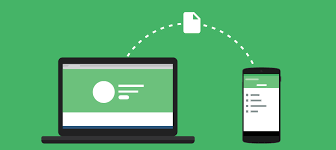
Transfer Files from Android to PC
Transferring data from your Android device to your PC is a task that often arises whether you need free up storage space on your phone or securely back up your files.
Fortunately, multiple methods are available to transfer data from Android to PC seamlessly.
In this article, we will explore six reliable and efficient ways to accomplish this task. These will ensure that you can effortlessly manage your files and keep them safe.
Method 1. Easiest Way to Transfer Files from Android to PC Selectively
When it comes to selectively transferring files from your Android device to your PC, there’s a powerful tool that stands out from the rest: DroidKit. This highly recommended solution offers a seamless and efficient way to handpick and transfer specific files.
What Is DroidKit?
In the realm of Android data management, one name shines brightly: DroidKit – #1 Complete Android solution. With it, you can control your data fully.
DroidKit is a versatile and user-friendly tool that revolutionizes the way you manage your Android data. Its intuitive interface and robust capabilities make it a go-to choice for those seeking a hassle-free file transfer experience.
Features of DroidKit
- Selective File Transfer: Support to choosing specific files, such as photos, videos, messages, contacts, and several others. Saving time and storage space.
- Ensure Picture Quality: Copy the original pictures to the computer instead of the compressed pictures.
- Easy-to-Use & High Security: No root requirement. As simple as possible. 100% secure, no data will be leaked, protecting your private files.
- High Transfer Speed: Transfer 1500 + photos in 3 minutes. Transfer large files or significant data in a matter of seconds.
- Wide Compatibility: Supports various brands and models. Including Samsung, Google Pixel, LG, HTC, or any other Android device, DroidKit has got you covered.
It is also a full-way Android solution for you. It can help you recover lost Android data, fix Android system issues, bypass FPR lock, recover deleted files on Android or a broken phone, remove any phone’s screen locks, etc.
Free get DroidKit and follow the step-by-step guide to transfer Android Data to a PC
Free Download * 100% Clean & Safe
How to Transfer Android Data to PC using DroidKit
Step 1. Download and run DroidKit on your PC > Tap on the Device Manager option under the Data Manager mode.
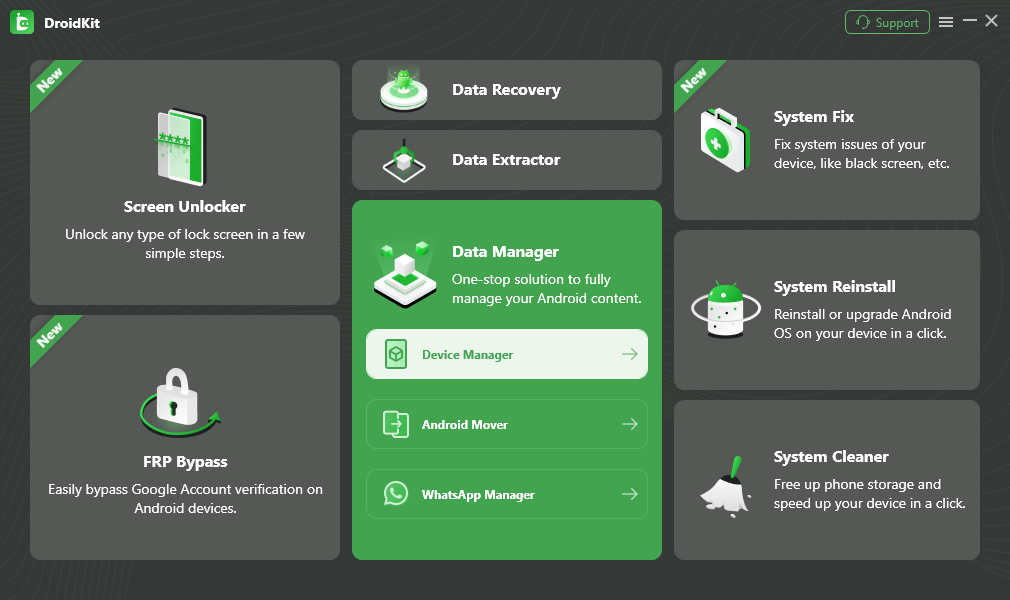
Choose the Device Manager
Step 2. Use a USB cord to connect your Android to your PC > Select Export Content, and choose any data category you’d like to transfer.
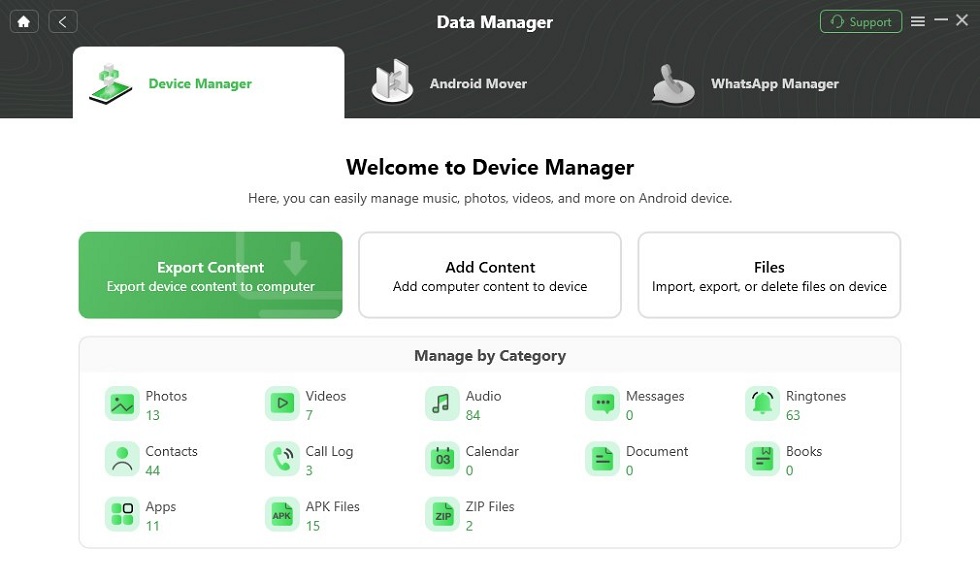
Choose Export Content
Step 3. Here we take photos as an example. When you preview all photos on your Android, select what you want to transfer and click To PC button.
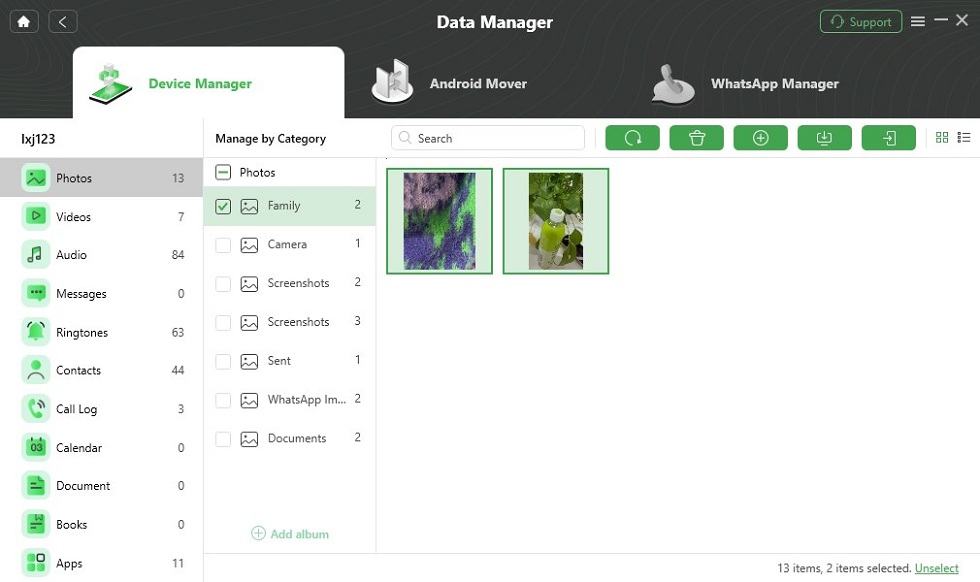
Choose Data You Want to Transfer
When the transfer process is completed, click View Files and you can check what you’ve transferred to PC as below.
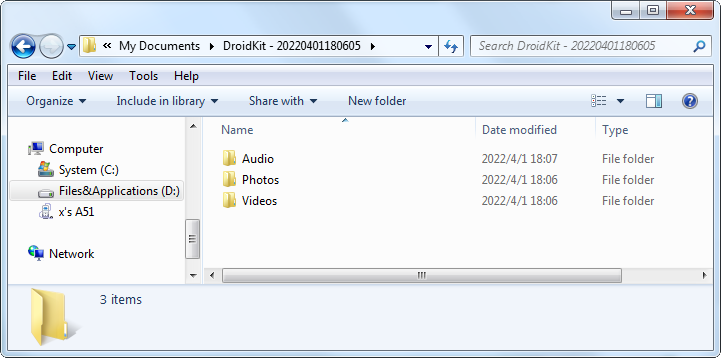
View Transferred Files on PC
Free Download * 100% Clean & Safe
Method 2. How to Transfer Files from Android to PC Using a USB Cable
Here, we will explore the traditional yet reliable method of transferring files from your Android device to your PC using a USB cable. This direct connection offers a secure and efficient way to transfer files of any size.
You can easily establish a connection between your Android device and PC. This will allow you to navigate through your device’s storage and transfer files with just a few clicks.
Step-by-Step Guide:
- Connect your Android device to your PC using a USB cable.
- On your Android device, swipe down from the top of the screen to access the notification panel.
- Tap on the USB connection notification and select the “File Transfer” or “MTP” mode.
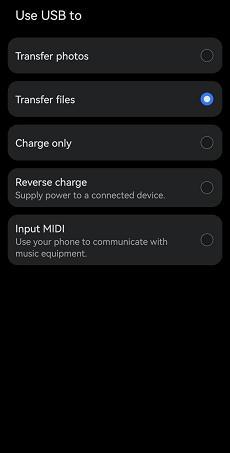
Choose “Transfer files.”
- Locate your Android device on your computer.
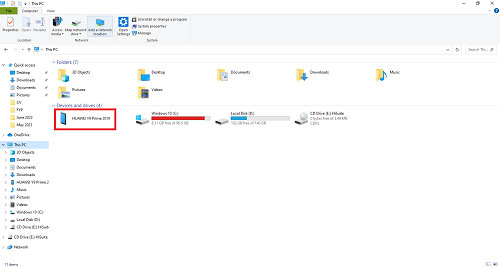
Locate Device
- Open the Android device folder to access its internal storage or SD card (if applicable).
- Copy the data you want to transfer and paste it to the desired location on your PC.
If USB cables don’t work for you, you can try out the SD card method.
Method 3. Transfer Files from Android to PC Using an SD Card
When it comes to transferring data from your Android device to your PC, utilizing an SD card offers a portable and versatile solution. In this section, we explore the simple yet effective method of using an SD card to seamlessly transfer your files.
This method ensures hassle-free file transfer, even without a USB cable.
Follow these quick steps to complete the transfer.
1: Save the files you want to transfer to your Android device’s microSD card.
2: Power off your Android device.
3: From your Android device, remove the microSD card.
4: Insert the microSD card into an SD card adapter.
5: Connect the SD card adapter to your PC’s card reader.
6: Open “My Computer” or “This PC” on your PC.
7: Locate the SD card in the file explorer.
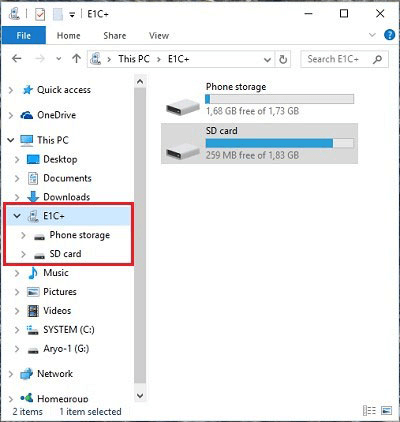
SD Card in File Explorer
8: Access the microSD card and copy the desired files from it to your PC.
If your Android device has no microSD card slot, you can use a USB OTG adapter to connect a USB SD card reader to your phone. This helps you to transfer files from the SD card to your Android device before transferring them to your PC.
Apart from USB cables and SD cards, you can also transfer data from Android to PC via Bluetooth.
Method 4. How to Transfer Files via Bluetooth
Now let us show you how to effortlessly transfer data from your Android device to your PC using the convenience of Bluetooth connectivity.
With just a few simple steps, you can effortlessly transfer your photos, videos, documents, and more straight from your Android device to your PC.
Say hello to a cable-free future and let your files fly through the airwaves with ease.
To finish the transfer, stick to these easy steps.
Step 1: Enable Bluetooth on both your Android device and your PC.
Step 2: Navigate to the folder or file you want to transfer on your Android device.
Step 3: Long-press on the file or folder and select the “Share” or “Send” option.
Step 4: Choose the “Bluetooth” option from the sharing menu.
Step 5: Select your PC’s Bluetooth name or device from the available devices list.
Step 6: Accept the Bluetooth file transfer request from your Android device on your PC.

Bluetooth Transfer
Step 7: The file transfer will start, and you’ll see the progress on both devices.
Step 8: The file will be saved on your PC once the transfer is complete.
Ensure that both devices are within the Bluetooth range during the transfer process for a successful and uninterrupted file transfer.
Now, let’s see how to use Cloud Storage to transfer files.
Method 5. Transfer Files from Phone to PC via Cloud Storage
We will now explore the seamless method of transferring files from your phone to your PC using the convenience and accessibility of cloud storage services.
By following the straightforward steps outlined in this section, you can securely and conveniently transfer your files between devices without the need for physical connections or cables.
Follow the steps given below.
- Sign in to a cloud storage service (e.g., Google Drive, Dropbox, OneDrive) on your phone and upload the files you want to transfer.

Upload Files
- On your PC, open a web browser and visit the website of the cloud storage service you’re using.
- Sign in to the same cloud storage account on your PC.
- Locate the uploaded files in your cloud storage account.
- Select the files you want to transfer and choose the “Download” or “Save” options.
- Specify the desired location on your PC to save the downloaded files.
Method 6. How to Transfer Files from Android to Computer via E-mail
In this part, we will explore a simple and widely used method to transfer data from your Android device to your PC: via e-mail. Learn how to effortlessly send files as attachments in an e-mail and access them on your computer.
Let’s dive into the step-by-step guide and unlock the world of effortless file sharing.
Step 1: Find the file you wish to transfer by opening your Android file manager.
Step 2: Long-press the file, select “Share” or “Send,” and choose your e-mail app.
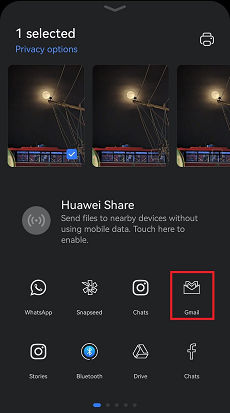
Share with your Email-App
Step 3: Compose a new e-mail, enter your own e-mail address as the recipient, and add a subject. Press send.
Step 4: On your computer, open your e-mail client or webmail and find the sent e-mail.
Step 5: Download the attached file to your computer.
You can easily send files from your Android mobile to your PC via email by following these simple steps.
Ensure a stable internet connection and sufficient e-mail storage for successful file transfer.
The Bottom Line
Transferring files from your Android device to your PC is no longer a daunting task, thanks to the array of workable methods available at your fingertips.
What’s more, DroidKit is our best alternative. It transfers Android files to PC at an astonishingly fast rate with no data loss. It also has many other features that can serve/manage your Android phone in one stop. DroidKit is worth a shot!
Free Download * 100% Clean & Safe
Happy file transferring!
Product-related questions? Contact Our Support Team to Get Quick Solution >

